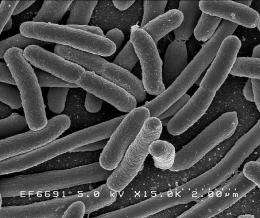May 10, 2012 report
Researchers undertake massive study of gut bacteria differences between people in different countries

(Medical Xpress) -- One area of human biology that is still a major mystery is the nature of the relationship between microorganisms (microbiomes) that exist in the gut and the health of the human host. Crohn's disease, for example is believed to be due to a problem with this relationship. Complicating matters is the apparent dearth of information regarding differences in microbiomes between people who live in different parts of the world; knowledge that would greatly help scientists figure out the role of different gut microbes and how they either help or hurt people. To that end, a large international group of researchers, led by Jeffrey Gordon, has been obtaining fecal samples from people in three different countries and comparing the differences in their microbiomes. They have, as they describe in their paper published in Nature, found both similarities and differences between the groups.
Human beings have ten times as many foreign microbes in their bodies as they have native human cells, yet scientists still have only a vague understanding of how the relationship between them works. One way to learn more is to look into the microbiomes of people that live not just distant from one another, but in vastly different environments. To that end, the researchers collected hundreds of fecal samples from people living in villages in rural Malawi, Africa, from rural Amerindians living in villages in the Amazon basin in Venezuela and from people living in cities in the United States. Samples obtained came from people of all ages, from just after birth to the elderly.
Not surprisingly, the team found that gut bacteria in the people in Malawi and Venezuela was a closer match than either to those found in the guts of Americans living in big cities. Both groups of villagers tended to have microbes that were good at processing foods that were high in fiber and complex sugars and starches, while those in the American group had higher percentages of microbes that are better at processing meats and refined sugar, which not coincidently, reflects what both groups tend to eat. They also found that the microbiomes of both village groups tended to be much more diverse than for the American group as a whole.
One similarity the team found was the way microbiomes appear to develop in babies. Humans from all over start out with a lot of just a few kinds of gut microbes and hold steady for the first six to nine months and then take at least a couple of years to develop the more complicated microbiomes of adults. Another similarity across all three groups were microbes that processed vitamins differently for infants versus adults. Infants had more bacteria that are a part of folate biosynthesis, while adults tended to have more that bugs that help with folate metabolism.
The study, a first of its kind, will likely lead to many more as researchers will likely want to know if city people in Africa, for example, have different microbiomes than do those in remote villages, of if those people that live in remote villages in the US have gut bacteria that is more similar to villagers in other countries versus those that live in American cities, etc. More research can only lead to more understanding and hopefully, breakthroughs in treatments when things go wrong.
More information: Human gut microbiome viewed across age and geography, Nature (2012) doi:10.1038/nature11053
Abstract
Gut microbial communities represent one source of human genetic and metabolic diversity. To examine how gut microbiomes differ among human populations, here we characterize bacterial species in fecal samples from 531 individuals, plus the gene content of 110 of them. The cohort encompassed healthy children and adults from the Amazonas of Venezuela, rural Malawi and US metropolitan areas and included mono- and dizygotic twins. Shared features of the functional maturation of the gut microbiome were identified during the first three years of life in all three populations, including age-associated changes in the genes involved in vitamin biosynthesis and metabolism. Pronounced differences in bacterial assemblages and functional gene repertoires were noted between US residents and those in the other two countries. These distinctive features are evident in early infancy as well as adulthood. Our findings underscore the need to consider the microbiome when evaluating human development, nutritional needs, physiological variations and the impact of westernization.
© 2012 Phys.Org
















